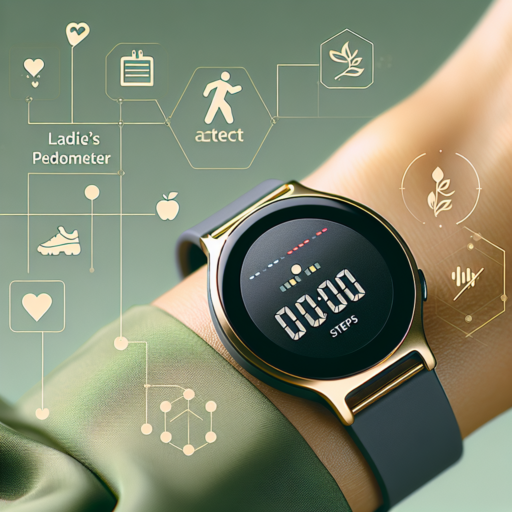Introduction to Watch Step Counters: Enhancing Your Fitness Journey
In the realm of health and wellness, watch step counters have emerged as a pivotal tool in encouraging individuals to lead more active and healthier lifestyles. These innovative gadgets provide an insightful glimpse into one’s daily activity levels, making fitness goals more attainable and tangible. The versatility and convenience of these devices have revolutionized the way people approach their fitness routines.
The genesis of watch step counters can be traced back to the simple pedometer, but with the advent of advanced technology, these devices have transformed significantly. Today, they are not just step counters; they incorporate a wide array of features such as heart rate monitoring, sleep tracking, and even smart notifications. This integration of functionalities makes them an indispensable tool for anyone looking to take their fitness journey to the next level.
Understanding the importance of these devices, it’s crucial to delve into how they work and the myriad ways they can bolster your fitness objectives. By accurately tracking your daily steps, these gadgets encourage a more active lifestyle, pushing you to achieve and often surpass your fitness targets. Furthermore, the instant feedback provided acts as a continuous motivator, fostering a cycle of positive reinforcement that is beneficial for sustainably maintaining an active routine.
How Watch Step Counters Work: The Technology Behind Tracking
Understanding the mechanics of watch step counters involves delving into the intriguing world of motion sensing and digital processing. At the heart of these devices lies an accelerometer, a small yet powerful sensor that plays a pivotal role in tracking movement. When you move, the accelerometer within the watch detects the motion and translates it into digital signals, enabling the device to count each step you take.
Accelerometers: The Core of Step Counting — Accelerometers are sophisticated sensors capable of detecting movement in multiple directions. They measure acceleration forces, whether static, like the force of gravity, or dynamic, to sense movement or vibrations. By analyzing these forces, step counters can distinguish between different types of motion, discerning steps from other movements to provide an accurate count.
Algorithm and Software Integration
The raw data from the accelerometer undergoes analysis through a specifically designed algorithm within the device’s firmware. This algorithm is crucial, as it filters out non-step movements and accurately counts each step. The sophistication of the algorithm and the software’s integration significantly determine the accuracy of step tracking. Hence, advancements in technology continuously refine these systems, enhancing the precision of step counters over time.
Top Features to Look for in a Watch Step Counter
When choosing a watch step counter, the myriad options available can be overwhelming. Yet, focusing on a few key features can greatly enhance your experience and ensure that your device meets your fitness tracking needs effectively.
Accuracy of Step Tracking
The primary feature to seek in a watch equipped with a step counter is the accuracy of step tracking. High-precision sensors and sophisticated algorithms play a critical role in ensuring that each step you take is counted. This accuracy is vital for tracking your progress accurately over time and setting realistic fitness goals.
Battery Life
Another important consideration is the device’s battery life. Opt for a watch step counter that offers a balance between functionality and power efficiency, ensuring that you don’t have to constantly recharge the device. A long-lasting battery is especially crucial for those who plan to use their devices for extended periods or for tracking multi-day hiking adventures.
Water Resistance
For individuals who lead an active lifestyle or enjoy outdoor activities, selecting a watch step counter with water resistance is a smart choice. This feature not only extends the durability of your device but also allows you to engage in a variety of exercises, including swimming, without the worry of damaging your fitness tracker.
The Best Watch Step Counters of 2023: A Comprehensive Guide
In the world of fitness and health tracking, watch step counters have become indispensable tools for those aiming to maintain an active lifestyle. The year 2023 has seen remarkable innovations in this field, introducing devices that not only track steps with impressive accuracy but also offer a suite of additional functionalities to cater to the modern user’s holistic fitness needs. This guide aims to highlight key features and advancements that set the best watch step counters of the year apart from the competition.
Diverse Range of Health Metrics
The leading step counters of 2023 are not limited to merely counting steps; they’ve evolved into comprehensive wellness devices. Beyond basic step tracking, many of these gadgets now monitor heart rate, sleep quality, and even stress levels, providing users with a multifaceted picture of their health. Innovations such as oxygen saturation (SpO2) monitoring and electrocardiogram (ECG) readings are also becoming standard features, pushing the boundaries of what we expect from a typical step counter.
Enhanced Connectivity and Integration
Today’s best step counters boast unparalleled connectivity, seamlessly integrating with a wide array of devices and applications. This synchronization allows users to access their health data across different platforms, making it easier to set, track, and achieve fitness goals. Furthermore, the integration with smartphones enables features like notification mirroring and music control, ensuring that users stay connected without constantly having to reach for their phones. This level of integration enhances the user experience, making these devices invaluable companions in our daily lives.
User-Friendly Interfaces and Personalization
Ease of use and personalization are at the forefront of design in 2023’s top watch step counters. With intuitive interfaces and customizable dashboards, users can effortlessly navigate through their health statistics and personalize their devices to match their preferences. Moreover, the incorporation of vibrant, high-resolution displays makes engaging with these devices a pleasure, further motivating users to stay active and monitor their progress. Through thoughtful design and user-centric features, this year’s step counters have set a new standard for what users can expect from their fitness tracking devices.
No se han encontrado productos.
Integrating Your Watch Step Counter with Fitness Apps
Integrating your watch step counter with fitness apps can significantly enhance your physical activity tracking and help you achieve your health objectives in an efficient and enjoyable manner. Most modern smartwatches and fitness trackers come equipped with built-in pedometers designed to accurately record your daily step count. However, to unleash the full potential of your device, syncing it with a comprehensive fitness app can provide you with a more detailed analysis of your activity, along with personalized insights and recommendations.
Choosing the Right Fitness App is crucial for ensuring that the data from your watch step counter is utilized effectively. Popular fitness apps like MyFitnessPal, Google Fit, and Apple Health offer seamless integration with a wide range of devices. These platforms not only aggregate your step count data but also give you a holistic view of your health by tracking other important metrics such as calories burned, distance traveled, and even sleep quality. The synchronization process is usually straightforward, requiring you to grant permission for the app to access your device’s data.
Benefits of integration include enhanced accuracy in activity tracking and the ability to set and track personalized fitness goals. For instance, seeing how your daily steps translate into caloric expenditure can motivate you to increase your activity levels. Moreover, some apps allow you to participate in community challenges, adding a social element to your fitness journey that can be incredibly motivating. This feature connects you with a broader community of users who share similar goals, providing encouragement and competition to keep you engaged.
Watch Step Counters vs. Smartphone Apps: Which Is More Accurate?
In the journey of maintaining a healthy lifestyle, counting steps has become a popular approach. While some prefer the traditional watch step counters, others lean towards the modern convenience of smartphone apps. The question of accuracy between these two methods is a topic of interest for many fitness enthusiasts and health-conscious individuals.
Watch step counters are designed specifically for tracking physical activity, including the number of steps. Their built-in sensors and algorithms are optimized for this purpose, allowing them to closely monitor movements. On the other hand, smartphone apps rely on the phone’s accelerometer to track steps. While these apps are convenient and easily accessible, their accuracy can be influenced by where the phone is carried – whether it’s in your hand, pocket, or a bag.
Factors Influencing Accuracy
Several factors can impact the accuracy of both watch step counters and smartphone apps. The precision of the device’s sensor, the algorithm used for counting steps, and how the device or phone is carried can all play a significant role. For instance, a watch worn firmly on the wrist will have consistent readings, whereas the position of a smartphone can vary greatly throughout the day, potentially leading to less reliable counts.
- Watch step counters often offer more consistent sensor positioning.
- Smartphone apps might not be as accurate if the phone is carried inconsistantly.
- Both methods have advanced in accuracy with technological improvements.
The debate over accuracy between watch step counters and smartphone apps continues as technology evolves. While watches may offer more specialized features for activity tracking, the convenience and multifunctionality of smartphones make them a compelling choice for many. Understanding the nuances of each can help individuals make informed decisions about which method best suits their lifestyle and fitness goals.
Maintaining Your Watch Step Counter: Tips and Tricks
Keeping your watch step counter accurate and in top condition is essential for tracking your daily activities effectively. While these devices are designed to be resilient, regular maintenance can extend their life and ensure they provide the most accurate data. Whether you have a smartwatch or a fitness tracker, a few simple practices can make a big difference.
Periodic Cleaning
First and foremost, cleanliness is key. Sweat, dirt, and oil can accumulate on your device, potentially interfering with its sensors. To clean your watch step counter, use a soft, lint-free cloth slightly dampened with fresh water. Avoid using any harsh chemicals or abrasive materials that might damage the watch. For a deeper clean, especially after workouts or exposure to elements like sand or mud, gently wipe the band and the area around the sensors.
Software Updates
Regularly updating your device’s software is another crucial step. Manufacturers often release updates that improve accuracy, add new features, or fix bugs. Ensure your watch is connected to its companion app and check for updates periodically. This can usually be done through the settings menu of the app or the watch itself. Upgrading your software can enhance the step counter’s functionality and extend your device’s lifespan.
Lastly, be mindful of where and how you wear your watch. While most step counters are designed to be worn on the wrist, ensuring a snug but comfortable fit can enhance sensor accuracy. If the watch is too loose, it may not track your steps correctly. Moreover, avoid putting your watch in places where it could be easily damaged, such as pockets with keys or loose change.
Maximizing the Benefits of Your Watch Step Counter for Health and Fitness
Utilizing a watch step counter is a straightforward yet effective approach to monitor your daily activity and progress towards your health and fitness goals. By tracking the number of steps you take each day, you can gain insightful data that motivates you to improve your physical activity level. But, to truly maximize the benefits of your watch step counter, it’s essential to understand the most effective strategies for leveraging this powerful tool.
Setting Realistic Daily Step Goals
One of the first steps to maximizing your watch step counter’s benefits is to set realistic and achievable daily step goals. Health experts often recommend starting with a goal of 10,000 steps per day, but this might vary based on your current fitness level, health conditions, and lifestyle. Gradually increasing your target as you become more comfortable can help maintain motivation and avoid burnout. Regularly monitoring your progress towards these goals can spur significant improvements in your physical health and fitness levels.
Incorporating Varied Walking Intensities
Another way to enhance the benefits of your watch step counter is by varying the intensity of your walks. This can range from leisurely strolls to brisk walking sessions. Incorporating different intensities into your routine not only prevents boredom but also ensures that you are engaging different muscle groups and maximizing your calorie burn. Studies suggest that interval walking, which alternates between high-intensity and low-intensity periods, can be particularly effective in boosting cardiovascular health and stamina.
To truly maximize the health and fitness benefits of your watch step counter, it’s important to integrate these strategies into a comprehensive wellness plan. This means paying attention to not only your daily step count but also to other health metrics and lifestyle factors, such as sleep quality, dietary habits, and stress management. By doing so, you make each step count towards a healthier, more active lifestyle.
Real User Reviews: What to Expect from Your Watch Step Counter
Understanding the performance of your watch step counter through real user reviews can provide invaluable insights into what you might realistically expect from these wearable devices. Step counters, or pedometers, integrated into smartwatches have become a staple feature for those looking to monitor their physical activity levels. But, with a plethora of models on the market, how do users feel about their accuracy and usability?
User Experience and Accuracy
One of the primary concerns highlighted in real user reviews revolves around the accuracy of step counting. Users often compare the step count on their watch to other devices or apps to gauge accuracy, with mixed results. While some find their devices to be incredibly accurate, others note discrepancies that can sometimes be significant. Factors such as the device’s placement on the wrist, walking style, and the specific activities being monitored can all influence accuracy.
Additional Features and Battery Life
Aside from the basic function of counting steps, user reviews often delve into the additional features offered by their devices, such as heart rate monitoring, GPS tracking, and sleep analysis. These features are generally well-received, particularly when they integrate seamlessly with the step counter function. However, users frequently mention battery life as a consideration; more features tend to drain the battery faster, impacting how often the device needs to be charged.
Overall, real user reviews shed light on the practical, everyday use of watch step counters. While accuracy can vary, the general consensus is that these devices are handy tools for those looking to increase their physical activity. However, potential buyers are advised to consider what features they value most and how those features might affect the device’s overall performance and battery life.
Choosing the Right Watch Step Counter for Your Lifestyle and Budget
When it comes to maintaining an active lifestyle, having a reliable watch step counter can be a crucial tool for achieving your fitness goals. With the vast market of wearable technology available today, it can feel overwhelming to find the perfect match for your lifestyle and budget. However, by considering a few key aspects, you can make a decision that suits your needs seamlessly.
Understanding Your Fitness Needs
Before diving into the multitude of options, assess what your primary needs are from a step counter watch. Are you looking for a basic model that simply tracks your steps and calories, or are you in need of a more sophisticated device that offers GPS tracking, heart rate monitoring, and workout-specific data? Knowing what you value most in your fitness journey can significantly narrow down your choices and align you with a watch that complements your lifestyle.
Compatibility and User Experience
Another vital factor to consider is the watch’s compatibility with your smartphone and how user-friendly its interface is. A seamless connection between your watch and phone ensures that you can easily monitor your progress and set goals without any hassles. Additionally, a watch step counter with an intuitive interface and customizable features can make your fitness tracking much more pleasant and personalized.
Regardless of the numerous options on the market, remembering these key considerations can guide you towards a watch step counter that not only fits your budget but also enhances your daily routine and helps you stay on track with your fitness objectives. While the decision may seem daunting at first, focusing on what truly matters to you in terms of functionality and ease of use will lead you to the perfect companion for your health journey.




